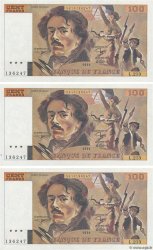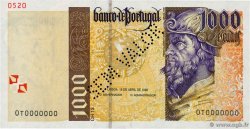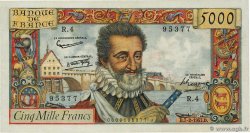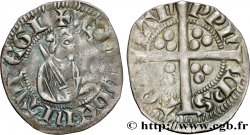E-auction 100-52743 - bpv_295677 - SYRIA - ROMAN PROVINCE - LABIENUS Tétradrachme syro-phénicien
You must signin and be an approved bidder to bid, LOGIN TO BID. Accounts are subject to approval and the approval process takes place within 48 hours. Do not wait until the day a sale closes to register. Clicking on « bid » constitutes acceptance of the terms of use of cgb.fr private e-auctions.
Bids must be placed in whole Euro amounts only. The sale will start closing at the time stated on the item description; any bids received at the site after the closing time will not be executed. Transmission times may vary and bids could be rejected if you wait until the last second. For further information ckeck the E-auctions F.A.Q.
NO BUYER'S FEE.
NO BUYER'S FEE.
| Estimate : | 350 € |
| Price : | 195 € |
| Maximum bid : | 200 € |
| End of the sale : | 16 March 2015 15:28:30 |
| bidders : | 12 bidders |
Type : Tétradrachme syro-phénicien
Date: 40-39 AC.
Mint name / Town : Antioche, Syrie, Séleucie et Piérie
Metal : silver
Diameter : 26 mm
Orientation dies : 12 h.
Weight : 14,80 g.
Rarity : R3
Coments on the condition:
Flan court mais date certaine
Catalogue references :
Predigree :
Notre exemplaire est le 0010_002 de la base TSP, et provient de la trouvaille de Livia et de la Collection Richard McAlee. C’est cet exemplaire qui illustre le type dans l’ouvrage de Richard McAlee The coins of Roman Antioch, page 69, n°10
Obverse
Obverse legend : ANÉPIGRAPHE.
Obverse description : Tête diadémée de Philippe Philadelphe à droite, entouré de la stemma (O’).
Reverse
Reverse description : Zeus assis à gauche sur un trône avec dossier, tenant de la main droite une Niké qui le couronne et un sceptre long de la main gauche ; au-dessus de Zeus, le foudre ; monogramme dans le champ à gauche ; date à l’exergue.
Reverse legend : BASILEWS/ FILIPPOU/ EPIFANOUS/ FILADELFOU, I(Basilews Filippou Epifanous Filadelfou)
Reverse translation : (Roi Philippe Epiphane Philadelphe/ monogramme d’Antioche et millésime 10 à l’exergue).
Commentary
An 10 de l’ère césarienne, exemplaire classique de la série intermédiaire entre les frappes séleucides et les frappes impériales syriennes.
Rien ne marque sur ce type la présence au pouvoir à Antioche d’un traître à Rome et à César, Labienus. Notons pourtant la rareté particulière des émissions de cette année 10 de l’ère césarienne, le métal monétaire ayant peut-être été utilisé pour les frappes à légendes latine.
La colonisation romaine est encore discrète et la prise de contrôle est aimable avec des constructions d’amphithéâtres, des travaux publics et des cérémonies. La monnaie, bien que contrôlée par Rome, reste au type séleucide et seul le petit monogramme indique la prise de pouvoir, ainsi que le millésime, ici l’an 10 de l’ère césarienne.
Notons que l’ère césarienne est conservée pour dater la monnaie, bien que le pouvoir politique à Antioche soit aux mains des Pompéiens.
Style classique pour l’émission avec les mèches traitées en “serpents”.
Les émissions au type immobilisé de Philippe Philadelphe sont très importantes car elles illustrent parfaitement la logique impériale de la colonisation romaine. Autant une conquête de revendication territoriale d'expansion de l'espace vital autour d'un pouvoir central de type national va chercher à éliminer toutes les symboliques locales dans les pays conquis pour imposer celles du conquérant (selon le principe de un peuple, un roi, une foi, une loi), autant un empire va laisser cohabiter des symboliques différentes. C'est ce qui se passe en Syrie, Palestine et Phénicie dans les premiers temps de l'expansion. Loin d'imposer le denier ou la typologie romaine, les Latins vont respecter la métrologie et même le type. Il faudra attendre les rares émissions d'Auguste au revers du Zeus, presque cinquante ans, pour voir apparaître le portrait du Prince sur les monnaies locales en argent.
Dans la base TSP maintenue par Michel Prieur, cinq exemplaires sont maintenant répertoriés, dont un au British Museum 1926-11-10-1.
Rien ne marque sur ce type la présence au pouvoir à Antioche d’un traître à Rome et à César, Labienus. Notons pourtant la rareté particulière des émissions de cette année 10 de l’ère césarienne, le métal monétaire ayant peut-être été utilisé pour les frappes à légendes latine.
La colonisation romaine est encore discrète et la prise de contrôle est aimable avec des constructions d’amphithéâtres, des travaux publics et des cérémonies. La monnaie, bien que contrôlée par Rome, reste au type séleucide et seul le petit monogramme indique la prise de pouvoir, ainsi que le millésime, ici l’an 10 de l’ère césarienne.
Notons que l’ère césarienne est conservée pour dater la monnaie, bien que le pouvoir politique à Antioche soit aux mains des Pompéiens.
Style classique pour l’émission avec les mèches traitées en “serpents”.
Les émissions au type immobilisé de Philippe Philadelphe sont très importantes car elles illustrent parfaitement la logique impériale de la colonisation romaine. Autant une conquête de revendication territoriale d'expansion de l'espace vital autour d'un pouvoir central de type national va chercher à éliminer toutes les symboliques locales dans les pays conquis pour imposer celles du conquérant (selon le principe de un peuple, un roi, une foi, une loi), autant un empire va laisser cohabiter des symboliques différentes. C'est ce qui se passe en Syrie, Palestine et Phénicie dans les premiers temps de l'expansion. Loin d'imposer le denier ou la typologie romaine, les Latins vont respecter la métrologie et même le type. Il faudra attendre les rares émissions d'Auguste au revers du Zeus, presque cinquante ans, pour voir apparaître le portrait du Prince sur les monnaies locales en argent.
Dans la base TSP maintenue par Michel Prieur, cinq exemplaires sont maintenant répertoriés, dont un au British Museum 1926-11-10-1.







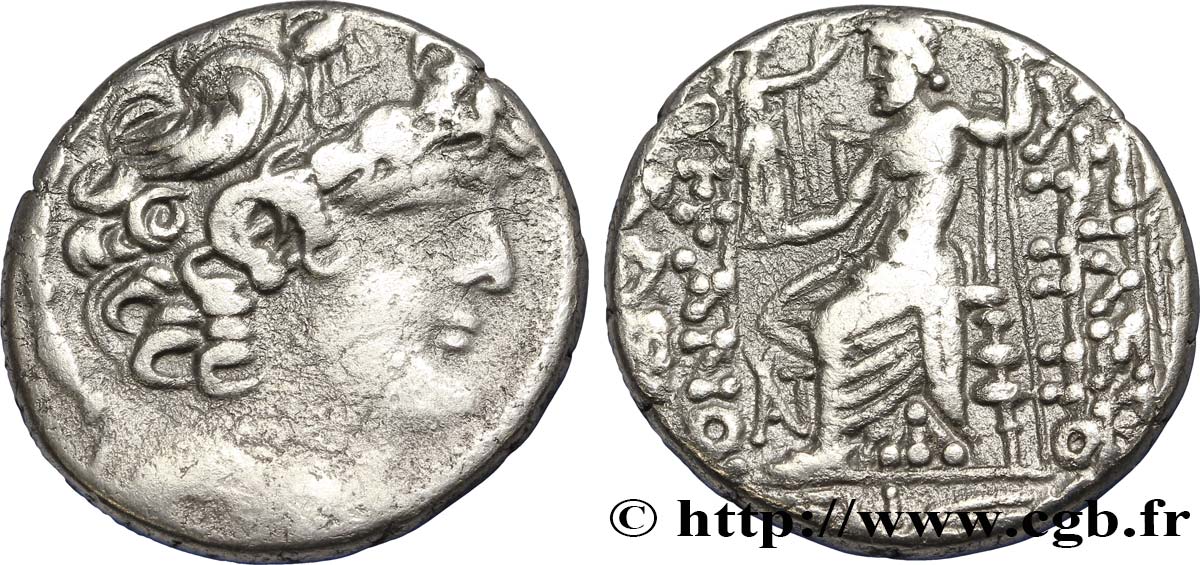
 Report a mistake
Report a mistake Print the page
Print the page Share my selection
Share my selection Ask a question
Ask a question Consign / sell
Consign / sell